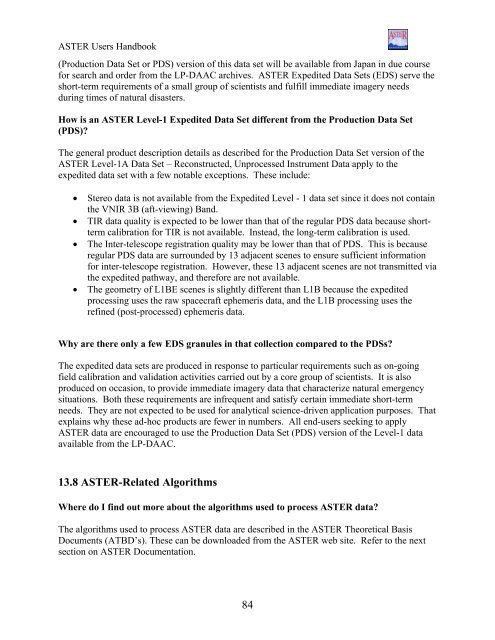<strong>ASTER</strong> Users Handbook(Production Data Set or PDS) version of this data set will be available from Japan in due coursefor search and order from the LP-DAAC archives. <strong>ASTER</strong> Expedited Data Sets (EDS) serve theshort-term requirements of a small group of scientists and fulfill immediate imagery needsduring times of natural disasters.How is an <strong>ASTER</strong> Level-1 Expedited Data Set different from the Production Data Set(PDS)?The general product description details as described for the Production Data Set version of the<strong>ASTER</strong> Level-1A Data Set – Reconstructed, Unprocessed Instrument Data apply to theexpedited data set with a few notable exceptions. These include:• Stereo data is not available from the Expedited Level - 1 data set since it does not containthe VNIR 3B (aft-viewing) Band.• TIR data quality is expected to be lower than that of the regular PDS data because shorttermcalibration for TIR is not available. Instead, the long-term calibration is used.• The Inter-telescope registration quality may be lower than that of PDS. This is becauseregular PDS data are surrounded by 13 adjacent scenes to ensure sufficient informationfor inter-telescope registration. However, these 13 adjacent scenes are not transmitted viathe expedited pathway, and therefore are not available.• The geometry of L1BE scenes is slightly different than L1B because the expeditedprocessing uses the raw spacecraft ephemeris data, and the L1B processing uses therefined (post-processed) ephemeris data.Why are there only a few EDS granules in that collection compared to the PDSs?The expedited data sets are produced in response to particular requirements such as on-goingfield calibration and validation activities carried out by a core group of scientists. It is alsoproduced on occasion, to provide immediate imagery data that characterize natural emergencysituations. Both these requirements are infrequent and satisfy certain immediate short-termneeds. They are not expected to be used for analytical science-driven application purposes. Thatexplains why these ad-hoc products are fewer in numbers. All end-users seeking to apply<strong>ASTER</strong> data are encouraged to use the Production Data Set (PDS) version of the Level-1 dataavailable from the LP-DAAC.13.8 <strong>ASTER</strong>-Related AlgorithmsWhere do I find out more about the algorithms used to process <strong>ASTER</strong> data?The algorithms used to process <strong>ASTER</strong> data are described in the <strong>ASTER</strong> Theoretical BasisDocuments (ATBD’s). These can be downloaded from the <strong>ASTER</strong> web site. Refer to the nextsection on <strong>ASTER</strong> Documentation.84
<strong>ASTER</strong> Users Handbook13.9 <strong>ASTER</strong> DocumentationThe Product Specifications for <strong>ASTER</strong> Level-1:http://asterweb.jpl.nasa.gov/documents/<strong>ASTER</strong>%20Data%20Prodcut%20Specification.pdfAlgorithm Theoretical Basis Documents (ATBDs) are detailed documents put together by thePrincipal Investigator(s) for a particular product. They provide an introduction, overview,theoretical description of the algorithm, the mathematics, programming and implementationconsiderations, constraints, limitations and assumptions. This is the definite source ofinformation for the serious researcher who requires a lot of background information on theory,methodology and further references.The ATBDs for <strong>ASTER</strong> Level-1 and higher-level products can be accessed from:<strong>ASTER</strong> Level-1Decorrelation StretchBrightness Temp. at SensorSurface Temp./EmissivitySurface Radiance & ReflectanceSurface Radiance - TIRPolar Surface Classification<strong>ASTER</strong> DEM<strong>ASTER</strong> Validation Plan<strong>ASTER</strong> Validation Summarieseospso.gsfc.nasa.gov/ftp_ATBD/REVIEW/<strong>ASTER</strong>/ATBD-AST-01/l1atbd.pdfeospso.gsfc.nasa.gov/ftp_ATBD/REVIEW/<strong>ASTER</strong>/ATBD-AST-06/atbd-ast-06.pdfeospso.gsfc.nasa.gov/ftp_ATBD/REVIEW/<strong>ASTER</strong>/ATBD-AST-02/atbd-ast-02.pdfeospso.gsfc.nasa.gov/ftp_ATBD/REVIEW/<strong>ASTER</strong>/ATBD-AST-03/atbd-ast-03.pdfeospso.gsfc.nasa.gov/ftp_ATBD/REVIEW/<strong>ASTER</strong>/ATBD-AST-04/atbd-ast-04.pdfeospso.gsfc.nasa.gov/ftp_ATBD/REVIEW/<strong>ASTER</strong>/ATBD-AST-05/atbd-ast-05.pdfeospso.gsfc.nasa.gov/ftp_ATBD/REVIEW/<strong>ASTER</strong>/ATBD-AST-07/atbd-ast-07.pdfeospso.gsfc.nasa.gov/ftp_ATBD/REVIEW/<strong>ASTER</strong>/ATBD-AST-08/atbd-ast-08.pdfeospso.gsfc.nasa.gov/ftp_ATBD/REVIEW/<strong>ASTER</strong>/VALIDATION/val-ast-full.pdfeospso.gsfc.nasa.gov/ftp_docs/<strong>ASTER</strong>_VAL_SUM_0901.pdfWhat on-line resources are available to learn more about <strong>ASTER</strong>?http://asterweb.jpl.nasa.govhttp://www.gds.aster.ersdac.or.jphttp://edcdaac.usgs.gov/dataproducts.htmlhttp://edcdaac.usgs.gov/asterondemand/index.htmlhttp://terra.nasa.govCan you give me a list of general overview articles/papers on <strong>ASTER</strong> that have thus farbeen published?A. KAHLE, F. PALLUCONI, S. HOOK, V.J. REALMUTO, and G. BOTHWELL, (1991) TheAdvanced Spaceborne Thermal Emission and Reflectance Radiometer (<strong>ASTER</strong>). Int. J.ImagingSystem Tech., vol. 3, pp. 144-156.FUJISADA, H., (1998) <strong>ASTER</strong> Level-1 Processing Algorithm.IEEE Transactions on Geoscience and Remote Sensing, Vol. 36, pp. 1101 - 1112.FUJISADA, H., (1994) Overview of <strong>ASTER</strong> Instruments on EOS-AM1 Platform.Proceedings, SPIE, International Society for Optical Engineering, Vol. 2268, pp. 14 - 36.YAMAGUCHI, Y., KAHLE, A., TSU, H., KAWAKAMI, T., and PNIEL, M. (1998) Overviewof <strong>ASTER</strong>. IEEE Transactions on Geoscience and Remote Sensing, Vol. 36, pp. 1062 – 107185















